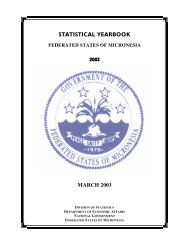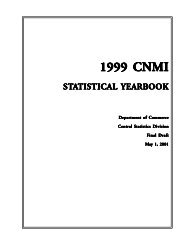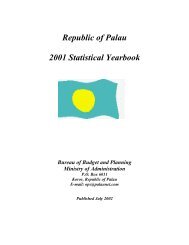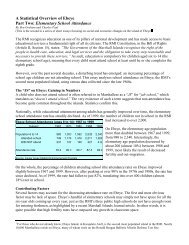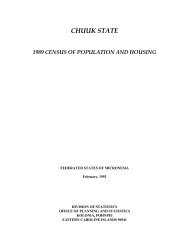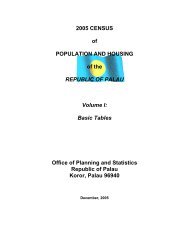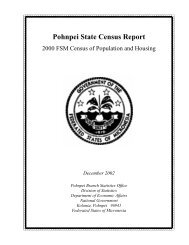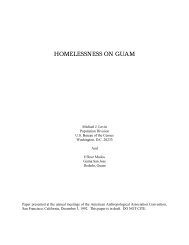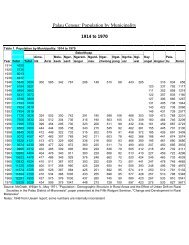Chuuk State Census Report - pacificweb.org
Chuuk State Census Report - pacificweb.org
Chuuk State Census Report - pacificweb.org
Create successful ePaper yourself
Turn your PDF publications into a flip-book with our unique Google optimized e-Paper software.
Chapter 1. Introduction2000 FSM <strong>Census</strong> of <strong>Chuuk</strong> <strong>State</strong>death on Tol. The Spanish sent a ship once more to investigate the disturbances and put an end to the trouble, but withno more success than before (L.J. Gorenflo, 1995).Table 1.1 shows in tabular form some of the early population estimates for <strong>Chuuk</strong> lagoon and a few of the outerislands. (Some of the estimates are from the German administrative period.)Table 1.1. Early Population Estimates for Major Island Units in <strong>Chuuk</strong> <strong>State</strong>: Selected YearsOuter IslandsYear <strong>Chuuk</strong> Lagoon Losap Nama Nomwin Houk Polowat1819 9001950 3501860 5001877 12,0001901 12,000 300 1,1001903 430 3201907 13,5141908 > 2001909 1771914 11,000Source: 1989 <strong>Chuuk</strong> <strong>State</strong> <strong>Census</strong> <strong>Report</strong>, Table 1.1; L.J. Gorenflo, 1995One result of Spanish period may have been an increased mortality from violence. Of course, no demographic dataexist from this period. Traders on <strong>Chuuk</strong> introduced iron and steel tools, which eventually replaced the bone and shelltools, but they also introduced guns to disastrous effect. Gladwin and Sarason, note, for example:On the small island of Romanum, less than a mile long ... warfare raged intermittently between people of thetwo ends of this one island. On the western end lived an American trader, while a Japanese trader occupied theeastern end, and each supplied the respective partisans with guns. The slaughter was considerable. And in themeanwhile, the people of Romanum also fought wars with villages on the neighboring islands of Udot and Tol(1953:40-41).German AdministrationThe Germans, who took over the islands from hapless Spain in 1899, found two dozen Japanese traders in <strong>Chuuk</strong>,including Koben Mori and Shirai. Among the trade goods that they were selling to the <strong>Chuuk</strong>ese in exchange for theircopra were liquor, guns, and dynamite. The German warship that arrived to announce the turnover of rule warned theJapanese that they were not to continue selling contraband articles to the people. Unlike the Spanish, the Germansintended to enforce their regulations. On a surprise visit two years later, German authorities found liquor and guns inthe Japanese warehouses, they expelled all the Japanese traders except Mori and served notice to the <strong>Chuuk</strong>ese peoplethat they intended to disarm them. The Germans also arrested three local chiefs accused of murder and hauled them offto Pohnpei to serve their jail sentences. This show of muscle had a sobering effect on the population. When theGermans returned in 1904 to make good on their promise to collect all arms, the <strong>Chuuk</strong>ese cooperated fully and turnedin nearly 500 guns.<strong>Chuuk</strong>, long known for its violence, submitted quietly and with a sense of relief to the German governor, as if thepeople had been waiting years for a show of leadership strong enough to compel their submission. Under the directionof the Germans, the <strong>Chuuk</strong>ese began clearing their land and planting coconut and fruit trees. The very chiefs who hadbeen the fiercest turned to building roads and docks, and leaders in all the islands furnished a count of their people forthe first census of the islands. Gratified by the progress shown, the Germans appointed flag chiefs to who they gaveauthority over the six regions of <strong>Chuuk</strong> lagoon. The copra industry prospered in <strong>Chuuk</strong>, and when Japanese merchantseventually returned, they did so under terms set by the German government. Now and then, the Germans were forcedto intervene in island affairs, as when they moved to put down a revival of traditional dancing in the Mortlocks thatthreatened to exhaust the population and deplete the food supply, but for the most part, <strong>Chuuk</strong> was a model colony.The Germans, who thought highly of <strong>Chuuk</strong>ese, recruited several to serve as policemen on Pohnpei.The greatest disruption during this period was the terrible typhoon that struck the Mortlocks in March 1907, taking over200 lives and leaving many of the islands denuded. Emergency rations were sent to the stricken islands and more than700 Mortlockese were relocated in the months that followed -- first on Saipan and then on Pohnpei for permanentresettlement. These refugees became the nucleus of what would be a growing <strong>Chuuk</strong>ese community on Pohnpei. The4 <strong>Chuuk</strong> Branch Statistics Office, Division of Statistics, FSM Department of Economic Affairs



